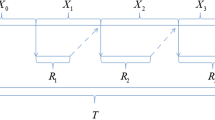Summary
Optimum preventive maintenance policies for a two-unit standby redundant system are reviewed. Under the assumptions that all distributions are arbitrary, the first-passage time distributions, the transition probabilities, and the expected numbers of visits to a certain state are derived. Using the probabilistic quantities above, we discuss the optimum preventive maintenance policies maximizing or minimizing some criteria. We show that under suitable conditions there exist the optimum preventive maintenance policies which are given by the unique solutions of the equations. This paper concludes with numerical examples of such optimum preventive maintenance policies.
Zusammenfassung
In diesem Aufsatz werden optimale Strategien zur vorbeugenden Instandhaltung für ein System mit zwei Maschinen besprochen, wobei eine Maschine die Ersatzmaschine darstellt. Unter der Annahme willkürlicher Verteilungen werden die Verteilung der Zeit für den ersten Durchgang, die übergangswahrscheinlichkeiten und die erwartete Zahl des Erreichens eines bestimmten Zustandes abgeleitet. Anhand der oben erwähnten Wahrscheinlichkeitswerte werden optimale Strategien zur vorbeugenden Instandhaltung besprochen, die bestimmte Kriterien maximieren oder minimieren. Es wird gezeigt, daß bei entsprechenden Bedingungen optimale Strategien zur vorbeugenden Instandhaltung existieren, die man als eindeutige Lösung eines Gleichungssystems erhält. Am Ende des Aufsatzes werden numerische Beispiele für optimale Strategien gegeben.
Similar content being viewed by others
References
Barlow, R. E., andF. Proschan: Mathematical Theory of Reliability, New York 1965.
Epstein, B., andJ. Hosford: Reliability of Some Two-Unit Redundant Systems. Proc. 6th Nat'l Symp. on Reliability and Quality Control, pp. 469–476, 1960.
Gaver, Jr., D. P.: Time to Failure and Availability of Paralleled Systems with Repair. IEEE Trans. ReliabilityR-12, 30–38, 1963.
—: Failure Time for a Redundant Repairable System of Two Dissimilar Elements. IEEE Trans. ReliabilityR-13, 14–22, 1964.
Gnedenko, B. V., Yu. K. Belyayev, andA. D. Solovyev: Mathematical Methods of Reliability Theory, English Translation, New York 1969.
Mazumdar, M.: Reliability of Two-Unit Redundant Repairable Systems When Failures Are Revealed by Inspections. SIAM J. Appl. Math.19, 637–647, 1970.
Morse, P. M.: Queues, Inventories and Maintenance, New York 1958.
Nakagawa, T., andS. Osaki: Stochastic Behaviour of a Two-Unit Standby Redundant System. INFOR12, 66–70, 1974a.
—: Optimum Preventive Maintenance Policies for a 2-Unit Redundant System. IEEE Trans. ReliabilityR-23, 86–91, 1974b.
—: Optimum Preventive Maintenance Policies Maximizing the Mean Time to the First System Failure for a Two-Unit Standby Redundant System. J. Optimization Theory and Appl.14, 115–129, 1974c.
—: Stochastic Behavior of a Two-Dissimilar-Unit Standby Redundant System with Repair Maintenance. Microelectronics and Reliablity13, 143–148, 1974d.
—: Stochastic Behavior of 2-Unit Standby Redundant Systems with Imperfect Switchover. IEEE Trans. ReliabilityR-24, 143–146, 1975.
Osaki, S.: System Reliability Analysis by Markov Renewal Processes. J. Operations Research Soc. Japan12, 127–188, 1970.
—: Reliability Analysis of a Two-Unit Standby-Redundant System with Preventive Maintenance. IEEE Trans. ReliabilityR-21, 24–29, 1972.
Osaki, S., andT. Asakura: A Two-Unit Standby Redundant System with Repair and Preventive Maintenance. J. Appl. Prob.7, 641–648, 1970.
Rozhdestvenskiy, D. V., andG. N. Fanarzhi: Reliability of a Duplicated System with Renewal and Preventive Maintenance. Engineering Cybernetics (English Translation)8, 475–479, 1970.
Srinivasan, V. S.: The Effect of Standby Redundancy in System's Failure wirh Repair Maintenance. Operations Research14, 1024–1036, 1966.
Author information
Authors and Affiliations
Rights and permissions
About this article
Cite this article
Nakagawa, T., Osaki, S. A summary of optimum preventive maintenance policies for a two-unit standby redundant system. Zeitschrift für Operations Research 20, 171–187 (1976). https://doi.org/10.1007/BF01920262
Received:
Revised:
Issue Date:
DOI: https://doi.org/10.1007/BF01920262




